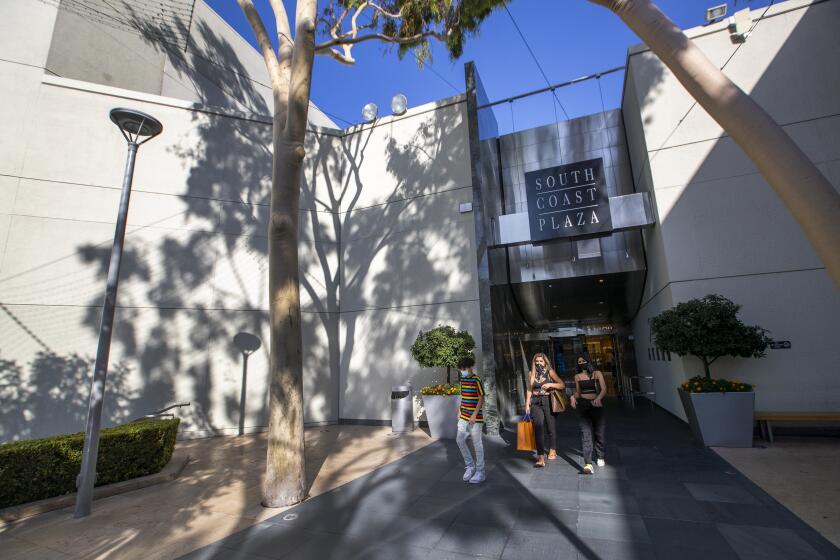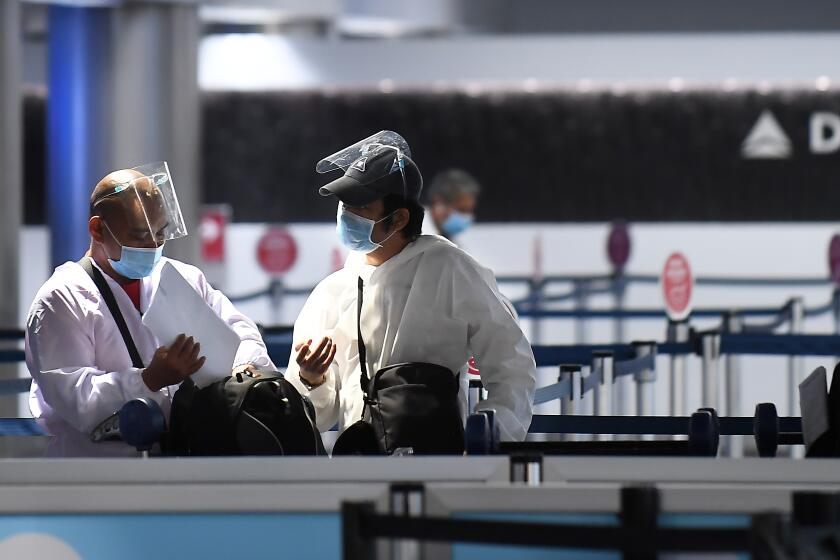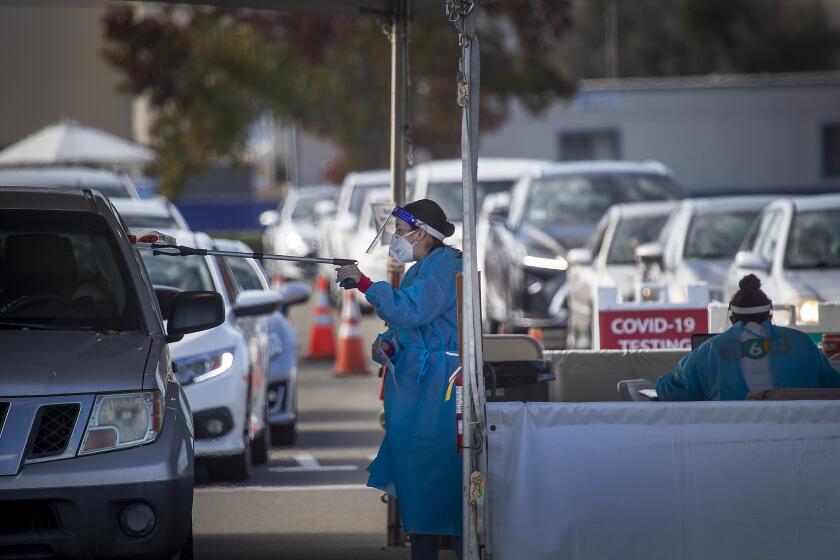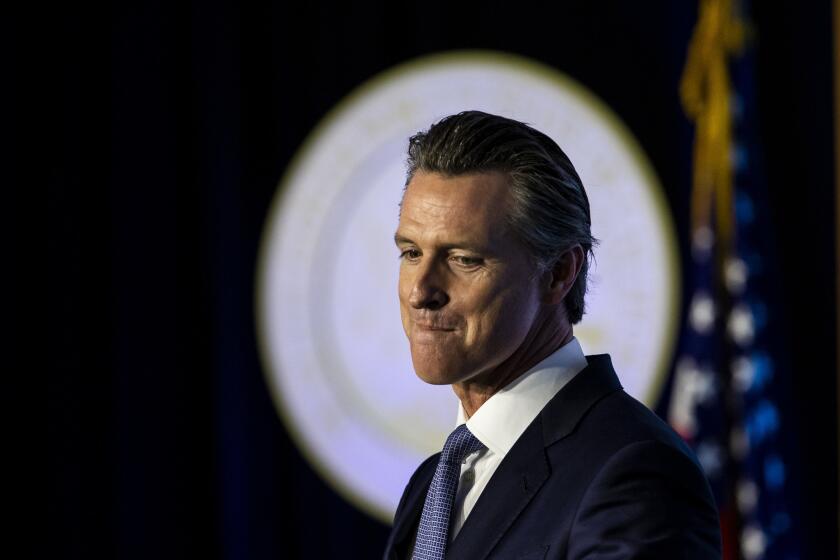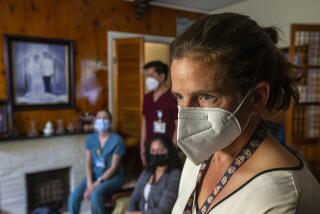California breaks single-day record for new COVID-19 cases amid sweeping new restrictions

In his weekly televised coronavirus update, California Gov. Gavin Newsom made the dramatic announcement of a possible statewide curfew on business activity amid the steepest rise in coronavirus cases that California had seen.
- Share via
California officials on Monday pulled what they characterized as an emergency brake, announcing a dramatic rollback of reopening in much of the state as it broke its single-day record for new coronavirus cases.
Once the changes go into effect Tuesday, 94% of Californians — roughly 37 million people — will live in counties that are in the strictest tier of the state’s reopening roadmap. Many businesses in those counties will have to suspend or severely limit their indoor operations.
The move came as California recorded 13,412 new cases Monday, according to The Times’ coronavirus tracker. That is the highest daily total since the pandemic began and a sign of how quickly the coronavirus is spreading.
“We are seeing community spread broadly now throughout the state of California,” Gov. Gavin Newsom said.
Last week, just 13 of California’s 58 counties were in the strictest tier, purple, indicating widespread transmission of the disease. Newsom announced Monday that the number would more than triple, to 41.
Among the counties that have newly fallen back into the purple tier are Orange, Ventura, Santa Barbara, Kern and San Luis Obispo. Los Angeles, San Bernardino, Riverside, San Diego and Imperial counties were already in that category.
Gov. Gavin Newsom has announced a stay-at-home order affecting most of California.
The most populated counties in the Bay Area were also sent back to the purple tier, including Santa Clara, Alameda, Contra Costa, Napa and Solano. All eight counties in the San Joaquin Valley are now in the purple tier.
The purple swath also covers all of California’s Central Coast and much of the area in and around Sacramento County.
Among counties in the purple tier, California officials require that the following types of indoor settings be closed to the public: restaurant dining rooms, gyms, dance and yoga studios, movie theaters, museums, zoos and aquariums. Houses of worship can no longer hold in-person services indoors, and most retail stores, indoor malls and libraries can only open to 25% capacity; grocery stores are allowed to open to 50% capacity.
Monday’s announcement comes amid the steepest rise in coronavirus cases that California has seen. Over the seven-day period that ended Sunday, the state averaged 7,985 cases per day, a rate that has nearly doubled in the past two weeks, according to data compiled by The Times.
The rolling metric hasn’t been that high since mid-August, and it is a far cry from just a month ago, when the seven-day average of new cases dipped below 3,000.
“This is simply the fastest increase California has seen since the beginning of this pandemic,” Newsom said.
Los Angeles County reported more than 3,000 new infections on both Saturday and Sunday; the 3,780 cases on Saturday represented the highest one-day total since mid-July.
Even on Monday, when case counts are typically lower because of reporting lags over the weekend, officials announced 2,795 new cases.
“It is clear that L.A. County is at a very dangerous point in the pandemic,” county Public Health Director Barbara Ferrer said.
All counties in Southern California are now in the purple tier, the most restrictive of the state’s reopening blueprint.
As the case count swells, officials stress that it’s essential for residents to follow infection prevention protocols: Wear a mask in public, wash hands regularly, stay home when sick and keep a physical distance from, and avoid gathering with, those outside your household.
None of those are novel concepts in the battle against the coronavirus. As Ferrer put it, “This isn’t like we don’t know what to do. This is about getting back to doing what works.”
“As a community and as individuals, we’re going to need to be laser-focused on reducing transmission,” she said during a briefing. “To say many lives are at stake is not an exaggeration.”
Weekly coronavirus cases have doubled in the last month around California. Officials are trying to slow this latest spike while minimizing further business closures.
The widespread reassignment announced Monday means that only 17 counties won’t be subject to the most stringent restrictions on businesses and other facilities outlined in California’s four-tier, color-coded blueprint.
Once the changes go into effect, 11 counties will be in the second-most severe, or red, category: Del Norte, Modoc, Humboldt, Plumas, Colusa, Lake, Marin, San Francisco, San Mateo, Amador and Mono.
Four are in the third, orange, tier — Lassen, Sierra, Calaveras and Inyo — and only two, Alpine and Mariposa, remain in the least-restrictive, yellow, tier.
Even more changes could be coming. Although California has typically updated its tier assignments weekly on Tuesdays, Newsom said those determinations would now be made and announced closer to real time.
“We need now to be more aggressive,” he said, “more surgical, more targeted.”
The tier system categorizes counties based on their average daily number of new coronavirus cases for every 100,000 residents and the percentage of conducted tests that detect the virus.
Counties used to regress only if their metrics fell in the range of a more restrictive tier for two straight weeks. Now, those decisions can be made based on one week’s worth of data.
Some counties saw their metrics worsen this week to the point that they slid back multiple categories. Among them was San Francisco, which was long hailed as a coronavirus success story but is now “seeing an explosion of new cases throughout the city,” Public Health Director Grant Colfax said during an online news conference.
A travel advisory issued Friday encourages Californians to stay local and avoid nonessential travel, and asks those who arrive from another state or country to self-quarantine for 14 days.
Though some of California’s increased case count is likely the byproduct of ramped-up testing, the rate at which those tests are coming back positive is also increasing. About a month ago, the seven-day positivity rate stood at 2.58%. Now, it’s 5%.
The number of those infected with the coronavirus who are ill enough to require hospitalization has also spiked in recent weeks. As of the latest tally, there were 3,852 COVID-19 hospitalizations statewide — up roughly 48% from two weeks ago. There are 1,031 COVID-19 patients in intensive care.
“As I say to my patients often, ‘When I’m worried, I’ll tell you, so you can worry with me.’ And we’re there,” said Dr. Mark Ghaly, California’s Health and Human Services secretary.
Eventually, “about 12% of those cases end up in the hospital,” he said during a briefing Friday, “and when you look at a high number of cases day over day, and that’s sustained, that’s exactly what we worry about in terms of overwhelming our hospital system.”
A surge in COVID-19 cases over the weekend worries Los Angeles County officials.
More than 1 million Californians have been diagnosed with COVID-19 at some point during the pandemic. Although most have recovered, more than 18,200 have died.
The spate of new cases comes as California — and the rest of the nation — heads into what officials already predict will be a particularly dangerous time for the pandemic, when cooler temperatures push people indoors and holidays tempt residents to gather with other households.
Last week, Newsom issued an advisory recommending that residents avoid unnecessary travel — including for Thanksgiving — and urging those who do head out of the state to self-quarantine for 14 days when they return.
As the latest surge shows no signs of slowing, some L.A. County officials have discussed potentially limiting businesses’ hours or instituting some type of curfew in a bid to stymie community spread.
Newsom said the state, too, was assessing the possibility of a curfew, though the idea is still being studied.
Though Ghaly and other health officials have regularly preached that personal responsibility is key to warding off the worst the pandemic can bring, it remains to be seen what additional measures California could contemplate if that message falls on deaf ears. That’s an especially worrying possibility as some residents and businesses grow increasingly tired of, or resentful toward, the sacrifices they’ve been asked to make for months.
Among those who have stumbled is Newsom, who has come under fire after attending a birthday party with other households at an upscale Napa Valley restaurant.
“I want to apologize to you, because I need to preach and practice, not just preach and not practice, and I’ve done my best to do that,” he said Monday. “We’re all human. We all fall short sometimes.”
Newsom acknowledged his decision to visit the Michelin-starred restaurant with other families may diminish his moral authority on COVID-19.
Thanksgiving could prove a particularly hard sell for pandemic-weary Californians. The state has generally banned large gatherings — although brief, small ones of no more than three households may be held, provided they take place outdoors and attendees physically distance and wear face coverings.
Whether large numbers of families will willingly forgo fellowship and food around the Thanksgiving table remains to be seen. Officials and experts say it’s safest to connect with extended friends and family through video calls or by phone, while limiting in-person celebrations to those you live with.
“I know everybody wants to know what to do for Thanksgiving, and the basic answer — to be the Grinch who stole Thanksgiving — is not to do it,” Dr. George Rutherford, an epidemiologist and infectious disease expert at UC San Francisco, said at a recent campus town hall meeting.
Times staff writers Maura Dolan, Taryn Luna, Alex Wigglesworth, David Zahniser and Iris Lee contributed to this report.
More to Read
Sign up for Essential California
The most important California stories and recommendations in your inbox every morning.
You may occasionally receive promotional content from the Los Angeles Times.

